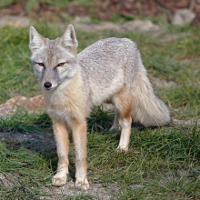 |
Corsac fox |
|
He is a wild animal |
Origin |
Central Eurasia | |
Translation |
Francis Vandersteen |
| The possession of this animal is not authorized Royal Decree establishing the list of mammals not kept for production purposes that may be kept (M.B. 24.08.2009) |
| The corsac fox (Vulpes corsac) is a fox of the genus Vulpes and family Canidae, native to the steppes of Central Eurasia. The corsac is smaller than the common fox, about the size of a medium-sized dog (50 to 60 cm). Its tail measures twenty to thirty centimeters. Its coat is grayish with tawny legs, and its belly and chin are white. The head is medium-sized, with a pointed muzzle that is neither too long nor too short. Its teeth are smaller than those of the common fox. This species is found in Russia, Kazakhstan, Uzbekistan, Turkmenistan, Iran, Afghanistan, Tajikistan, Kyrgyzstan, China and Mongolia. The Corsac fox lives in the steppes, semi-deserts and deserts of Asia. It avoids tall-grass steppes, forests, mountains and agricultural areas. They generally take shelter in burrows dug by other animals. In the wild, Corsac foxes are nocturnal animals. In captivity, however, they are very active during the day. Normally, they never stay in the same burrow, moving south when hunting conditions become too harsh. They are relatively sociable, and it sometimes happens that several individuals stay in the same burrow. They have well-developed senses, making them good hunters, but they are rather slow for their size. It's not unusual to see them hunting in small groups. The Corsac fox is carnivorous. It eats mainly rodents, but also insects, pikas, birds and a few plants. The Corsac fox is monogamous, breeding between January and March. After a gestation period varying from 50 to 60 days, the female gives birth to a litter of 2 to 6 cubs. At birth, the cubs measure between 13 and 14 cm and weigh 60 to 65 g. They are blind, but already covered in light-brown fur. They open their eyes after 14 to 16 days and start eating meat after 28 days. They reach adult size after 4 months and sexual maturity around 9 months. With many groups eliminated by humans, or even climate change, there was no known program to protect this Corsican fox until August 2009. Since the end of the 19th century, it has been hunted on a large scale for its fur, the market for which still flourishes today. During the 17th century, it was a very popular pet. |






 English (United Kingdom)
English (United Kingdom)